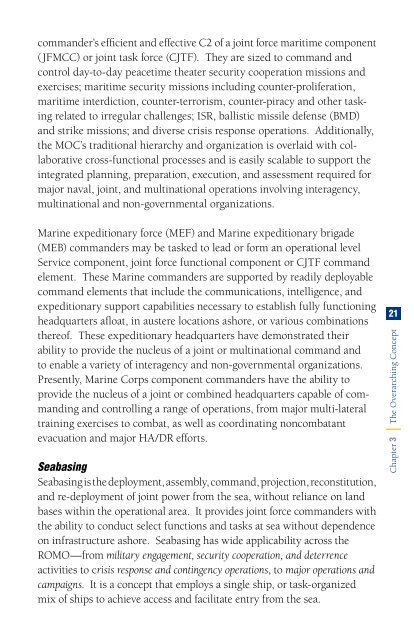Naval Operations Concept - Defense Technical Information Center
Naval Operations Concept - Defense Technical Information Center
Naval Operations Concept - Defense Technical Information Center
Create successful ePaper yourself
Turn your PDF publications into a flip-book with our unique Google optimized e-Paper software.
commander’s efficient and effective C2 of a joint force maritime component<br />
(JFMCC) or joint task force (CJTF). They are sized to command and<br />
control day-to-day peacetime theater security cooperation missions and<br />
exercises; maritime security missions including counter-proliferation,<br />
maritime interdiction, counter-terrorism, counter-piracy and other tasking<br />
related to irregular challenges; ISR, ballistic missile defense (BMD)<br />
and strike missions; and diverse crisis response operations. Additionally,<br />
the MOC’s traditional hierarchy and organization is overlaid with collaborative<br />
cross-functional processes and is easily scalable to support the<br />
integrated planning, preparation, execution, and assessment required for<br />
major naval, joint, and multinational operations involving interagency,<br />
multinational and non-governmental organizations.<br />
Marine expeditionary force (MEF) and Marine expeditionary brigade<br />
(MEB) commanders may be tasked to lead or form an operational level<br />
Service component, joint force functional component or CJTF command<br />
element. These Marine commanders are supported by readily deployable<br />
command elements that include the communications, intelligence, and<br />
expeditionary support capabilities necessary to establish fully functioning<br />
headquarters afloat, in austere locations ashore, or various combinations<br />
thereof. These expeditionary headquarters have demonstrated their<br />
ability to provide the nucleus of a joint or multinational command and<br />
to enable a variety of interagency and non-governmental organizations.<br />
Presently, Marine Corps component commanders have the ability to<br />
provide the nucleus of a joint or combined headquarters capable of commanding<br />
and controlling a range of operations, from major multi-lateral<br />
training exercises to combat, as well as coordinating noncombatant<br />
evacuation and major HA/DR efforts.<br />
Seabasing<br />
Seabasing is the deployment, assembly, command, projection, reconstitution,<br />
and re-deployment of joint power from the sea, without reliance on land<br />
bases within the operational area. It provides joint force commanders with<br />
the ability to conduct select functions and tasks at sea without dependence<br />
on infrastructure ashore. Seabasing has wide applicability across the<br />
ROMO—from military engagement, security cooperation, and deterrence<br />
activities to crisis response and contingency operations, to major operations and<br />
campaigns. It is a concept that employs a single ship, or task-organized<br />
mix of ships to achieve access and facilitate entry from the sea.<br />
Chapter The Overarching <strong>Concept</strong>

















